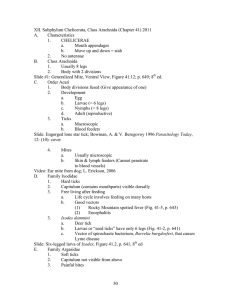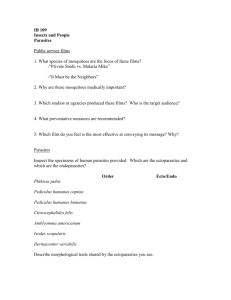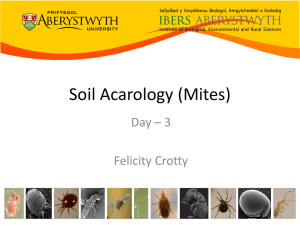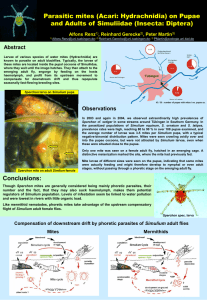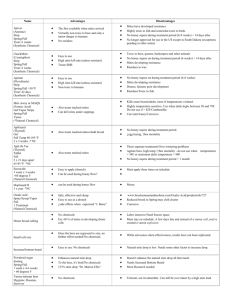Document 13378002
advertisement
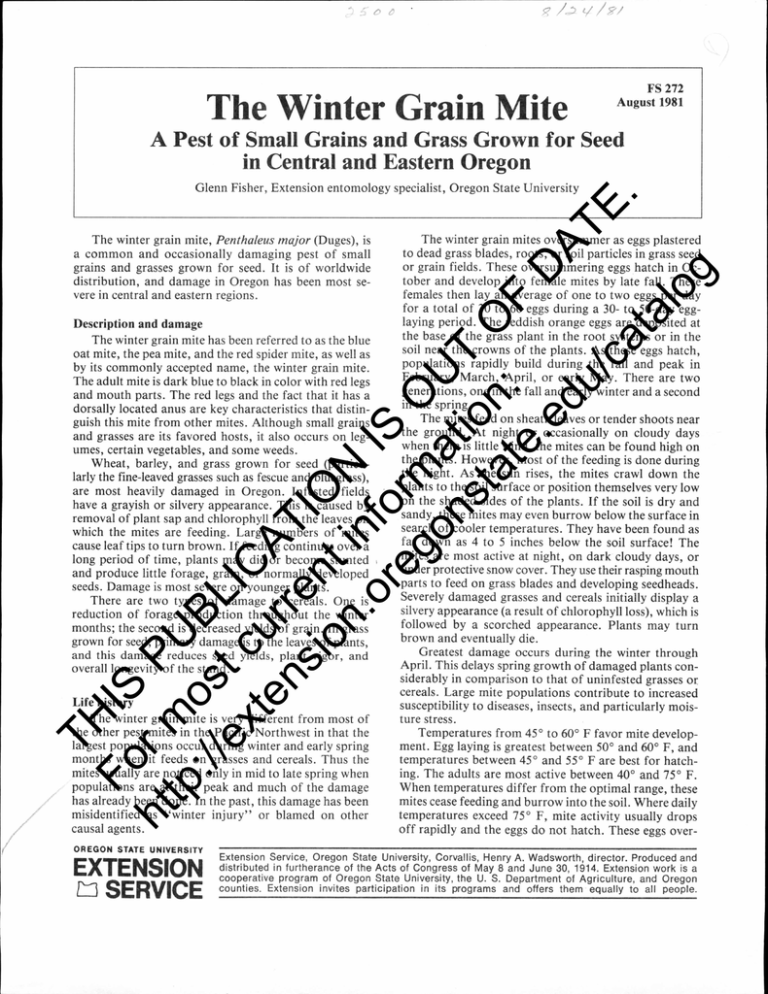
The Winter Grain Mite FS 272 August 1981 A Pest of Small Grains and Grass Grown for Seed in Central and Eastern Oregon Fo IS ht r m P U tp o :// s BL ex t c IC te ur A ns re TI io nt ON n. in or fo IS eg rm O on at U st ion T O at : F e. D ed A u/ TE ca . ta lo g Glenn Fisher, Extension entomology specialist, Oregon State University The winter grain mite, Penthaleus major (Duges), is a common and occasionally damaging pest of small grains and grasses grown for seed. It is of worldwide distribution, and damage in Oregon has been most severe in central and eastern regions. Description and damage The winter grain mite has been referred to as the blue oat mite, the pea mite, and the red spider mite, as well as by its commonly accepted name, the winter grain mite. The adult mite is dark blue to black in color with red legs and mouth parts. The red legs and the fact that it has a dorsally located anus are key characteristics that distinguish this mite from other mites. Although small grains and grasses are its favored hosts, it also occurs on legumes, certain vegetables, and some weeds. Wheat, barley, and grass grown for seed (particu- The winter grain mites oversummer as eggs plastered to dead grass blades, roots, or soil particles in grass seed or grain fields. These oversummering eggs hatch in October and develop into female mites by late fall. These females then lay an average of one to two eggs per day for a total of 30 to 60 eggs during a 30- to 50-day egglaying period. The reddish orange eggs are deposited at the base of the grass plant in the root systems or in the soil near the crowns of the plants. As these eggs hatch, populations rapidly build during the fall and peak in February, March, April, or early May. There are two generations, one in the fall and early winter and a second in the spring. The mites feed on sheath leaves or tender shoots near the ground. At night or occasionally on cloudy days when there is little wind, the mites can be found high on the plants. However, most of the feeding is done during larly the fine-leaved grasses such as fescue and bluegrass), the night. As the sun rises, the mites crawl down the are most heavily damaged in Oregon. Infested fields have a grayish or silvery appearance. This is caused by on the shaded sides of the plants. If the soil is dry and removal of plant sap and chlorophyll from the leaves on which the mites are feeding. Large numbers of mites cause leaf tips to turn brown. If feeding continues over a long period of time, plants may die or become stunted and produce little forage, grain, or normally developed seeds. Damage is most severe on younger plants. There are two types of damage to cereals. One is reduction of forage production throughout the winter months; the second is decreased yields of grain. In grass grown for seed, primary damage is to the leaves of plants, and this damage reduces seed yields, plant vigor, and overall longevity of the stand. TH Life history The winter grain mite is very different from most of the other pest mites in the Pacific Northwest in that the largest populations occur during winter and early spring months when it feeds on grasses and cereals. Thus the mites usually are noticed only in mid to late spring when populations are at their peak and much of the damage has already been done. In the past, this damage has been misidentified as "winter injury" or blamed on other causal agents. OREGON STATE UNIVERSITY EXTENSION El] SERVICE plants to the soil surface or position themselves very low sandy, these mites may even burrow below the surface in search of cooler temperatures. They have been found as far down as 4 to 5 inches below the soil surface! The mites are most active at night, on dark cloudy days, or under protective snow cover. They use their rasping mouth parts to feed on grass blades and developing seedheads. Severely damaged grasses and cereals initially display a silvery appearance (a result of chlorophyll loss), which is followed by a scorched appearance. Plants may turn brown and eventually die. Greatest damage occurs during the winter through April. This delays spring growth of damaged plants considerably in comparison to that of uninfested grasses or cereals. Large mite populations contribute to increased susceptibility to diseases, insects, and particularly moisture stress. Temperatures from 45° to 60° F favor mite development. Egg laying is greatest between 50° and 60° F, and temperatures between 45° and 55° F are best for hatching. The adults are most active between 40° and 75° F. When temperatures differ from the optimal range, these mites cease feeding and burrow into the soil. Where daily temperatures exceed 75° F, mite activity usually drops off rapidly and the eggs do not hatch. These eggs over- Extension Service, Oregon State University, Corvallis, Henry A. Wadsworth, director. Produced and distributed in furtherance of the Acts of Congress of May 8 and June 30, 1914. Extension work is a cooperative program of Oregon State University, the U. S. Department of Agriculture, and Oregon counties. Extension invites participation in its programs and offers them equally to all people. summer and will hatch in the fall when adequate soil moisture from fall rains or snowfall is present. Light, loose, sandy soils are most favorable for the development of this mite, and damage is most severe in these fields. In all probability, this mite is spread from field to field by transportation of the oversummering eggs on straw or grain stubble, soil adhering to tractors or farm mites, or the numbers of mites required before yield losses occur, are not known for either the cereals or grasses grown for seed. Dryland crops usually are affected more seriously than crops receiving irrigation. Some research- ers have speculated that a miticide application to early seeded winter grain or established grass seed in November, as the oversummering generation begins to develop, may reduce or virtually eliminate populations of the winter grain mites the following spring. If used in the spring, miticides should be applied when daytime tem- Fo IS ht r m P U tp o :// s BL ex t c IC te ur A ns re TI io nt ON n. in or fo IS eg rm O on at U st ion T O at : F e. D ed A u/ TE ca . ta lo g implements, or on forage straw carried from the infested fields to uninfested fields. The oversummering eggs may be blown by wind from one area to another. This mite is a very poor traveler, migrating for just a very few feet. crops were not small grain or grasses, mites usually are absent or occur in extremely low numbers. The winter grain mite is susceptible to most insecticides and miticides registered for use on cereals and grass grown for seed. Levels of economic injury caused by TH Control Fields that have been producing small grain or grass seed continuously for 3 or more years harbor the heaviest infestations of this mite. Fields in small grains or grass grown for seed for 2 consecutive years will usually show light to moderate damage. In fields where the previous peratures exceed 50° F. Remember that most of the damage occurs in winter, but that the damage is most noticeable in late winter and early spring when the spring generation of mites is developing. Consult your field representative, Extension agent, or the Pacific Northwest Insect Control Handbook for specific chemical recommendations.

